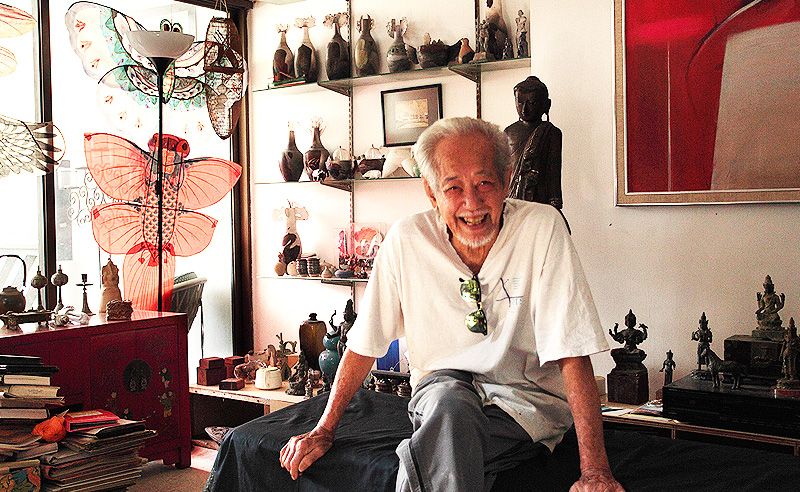Veteran artist Yeoh Jin Leng tells us about life in pre-Merdeka Malaysia and why at 88, he still continues to produce works of art.

A feeling of awe washed me over as I stepped into the house of artist Yeoh Jin Leng. Silk kites from Beijing adorned his ceiling, Batik pieces from Bali stood proudly on his walls while a hand-crafted apple wood table from Kashmir occupied the center space of his living area.
A renowned name in the Malaysian art industry, Jin Leng, has held prominent positions within many art institutions and organisations including The Malaysian Institute of Art and National Art Gallery along with creating designs for Royal Selangor.
Read also: Five ways to better Malaysia films as told by Gurinder Chadha
At 88, he remains one of the most respected artists in the country as he continues to surprise audiences with his creations, whether it is the Apsara metal sculptures or his charcoal renditions of the Malaysian east coast.

Besides being an established artist, potter, and sculptor, Jin Leng has also been an educator, teaching first in Ipoh and Kuala Terengganu and later at the Specialist Teacher Training College in Cheras, Kuala Lumpur.
We sit down with the veteran artist as he recalls his childhood, his artistic journey and travels across Europe and Asia with his rucksack being his only travel companion.

What was it like growing up in Malaysia under the colonial rule?
I grew up in a kampung in Ipoh. Back then, life was simple. We would go to school and later roam about in durian and mango estates, trying to steal some fruit to take back home. (laughs) No one really ruled us or told us what to do.
That changed though after the Japanese came to Malaysia. Their soldiers would mercilessly behead anyone they thought was against their propaganda and these executions would often take place right behind my house. Those were some dark days for Malaysia.
How was the spirit of the country at the time of Merdeka?
When the news of Merdeka reached me, I was overjoyed. At the time, I was overseas meeting with other art educators and I couldn’t have been prouder to say that I was now a part of an independent nation.
When I returned, celebrations were everywhere and we would go to Dataran Merdeka to watch the parades and speeches. It was a grand occasion.
So how did you begin practicing art?
Art just came to me naturally. I was attracted to the landscapes that surrounded me and wanted to turn everything I imagined into a painting. My art was never done for any reason.

When did you start pursuing arts more actively?
That would be around the time when I was living and teaching in Kuala Terengganu. I had just finished my training as a teacher from Kirkby and wanted to learn about European art and architecture.
However, I had no money to book flights and fancy hotels. So, I took my bicycle and a rucksack and just cycled around different countries like Switzerland, Rome, and Austria picking up aspects of Western art. I remember the immigration officers laughing at the weird Asian man on the bicycle as I crossed every checkpoint!
Do you feel it was difficult to keep arts alive at a time when the nation was hooked on producing more engineers and doctors?
Honestly, I couldn’t care less. I had my jungles, my landscapes, and my paints. At that time, no one bothered about an art market and art galleries and museums were almost non-existential.
It was only a couple of years later that I received a scholarship to further my art education at the Chelsea College of Arts, which was my first formal training in the field of arts.

You are now one of Malaysia’s oldest artist who still produces artworks. What keeps you going?
My love for nature and travels keeps me motivated to move forward.
I have travelled all over Southeast Asia and other parts of Asia to study our Asian heritage, traditions, cultures, and rituals. Armed with only my rucksack, sketchbook and pencils, I have lived with tribes in the longhouses of Sarawak, camped in the hilly regions of Chiang Mai and have visited several parts of India to understand our roots and personally, there is no better way to express these findings than through the arts.
As a former educator, do you think art education needs to become a part of the regular curriculum?
Unfortunately, our education system today does not give much importance to fine arts. We are more focused on mastering equations and theories and ultimately, we will end up locking away all the bits of our culture and heritage in a museum. We need art to make this country beautiful and to create thoughtful, kind-hearted citizens.

What would you say to the young artists of today?
Throw out all your fancy paints and pencils, buckets of them if possible and start exploring an idea first.
Unlike Western art, the paintings and artwork seen in Asian communities are inspired by a panoramic view of society. Take for examples, the scrolls from China and Japan. They are endless.
Such should be the beauty of your artwork. So, put aside realism, open-up, look deeper and create something that resonates for a long time.
Jin Leng and photographs by Almarhum Sultan Ismail Nasiruddin Shah, an exhibition displaying selected works of art by the critically acclaimed artist will be featured as a part of the KL International Arts Festival 2017 from September 11- 17, at The Edge Gallerie from 11am to 7pm with a special talk from Jin Leng on September 16.
(Photos: NN Gallery)
Singapore is spelt synonymously with glitz and glamour. Artist Tze Yang shows us 15 images of the city that will make you think otherwise.
